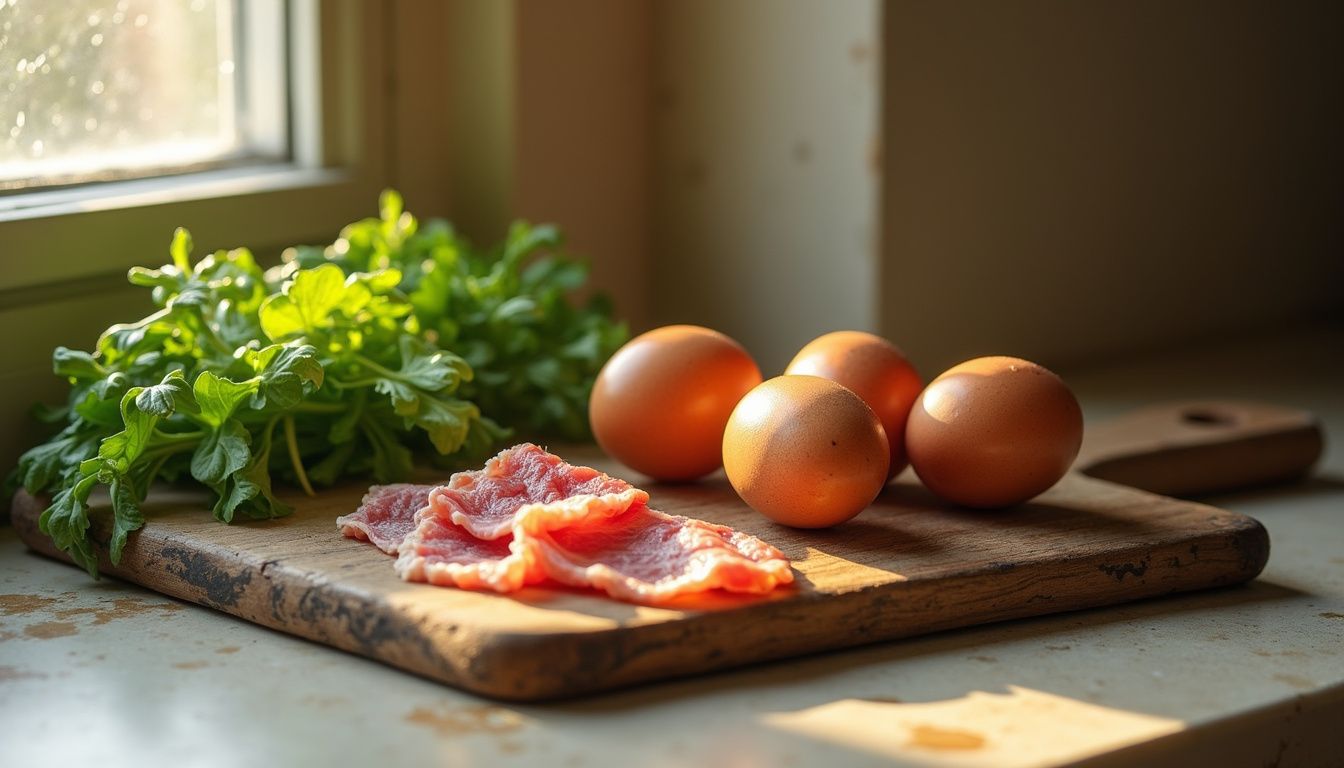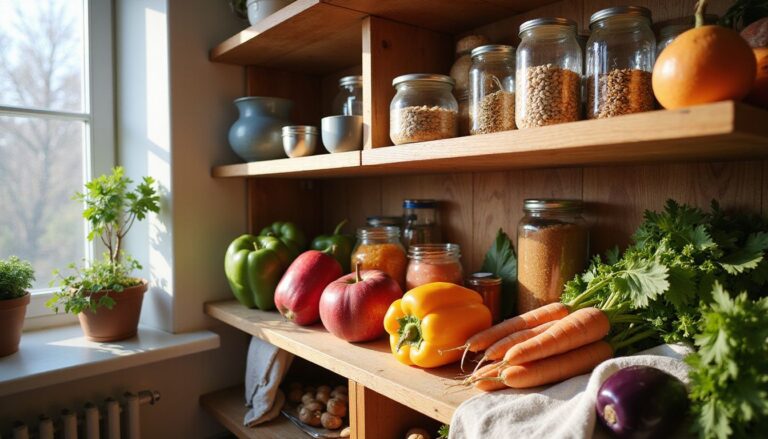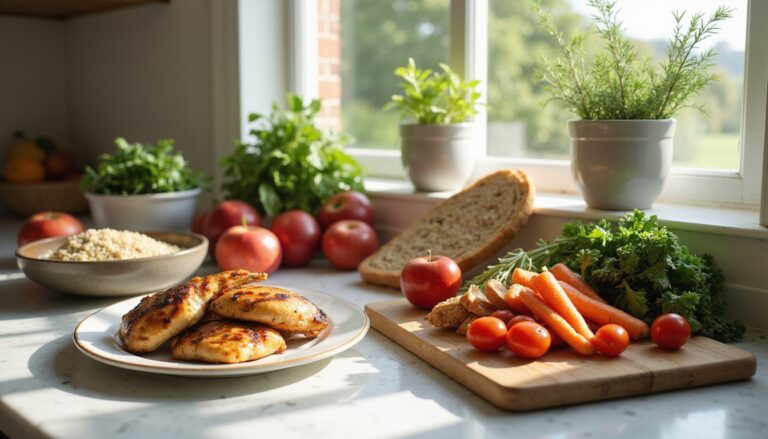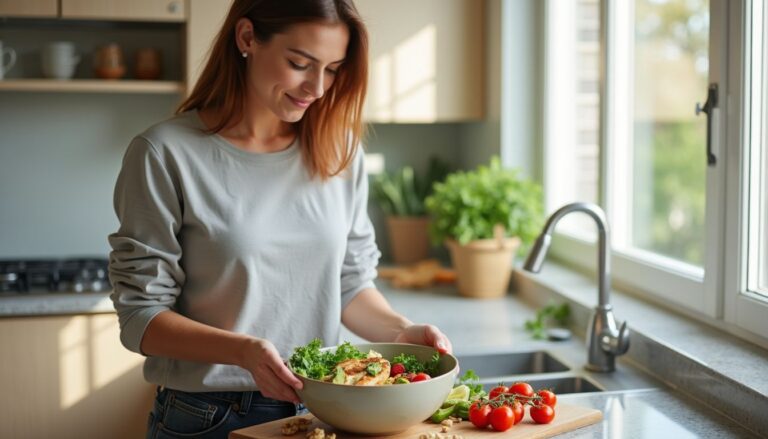Top 7 Healthy Foods To Lose Weight Fast: Mayo Clinic Diet And Calorie Tips
Our Nutrition Assistant AI Suite will transform your body. You will lose fat, get toned, and build muscle. Gain confidence and optimal health.
Trying to lose weight can feel confusing. Healthy foods that keep you full make the process easier. Choosing the right options supports weight loss without leaving you hungry.
Research points to nutrient-dense foods like eggs, leafy greens, beans, and lean meats. These choices curb cravings and supply vitamins, minerals, and protein. In this guide, you will see smart picks from the Mayo Clinic Diet and practical calorie tips you can use today.
Key Takeaways
- The Mayo Clinic Diet centers on low energy-dense foods like leafy greens, eggs, and lean proteins to support steady weight loss of 1–2 pounds per week.
- Calorie control matters. Many men do well near 1,900 calories per day and many women near 1,400, based on NHS guidance for safe weight loss.
- High water and high fiber foods, such as spinach, broccoli, berries, and broth soups, help you feel full while keeping calories low.
- Pairing high-protein foods, like fish and Greek yogurt, with high-fiber foods, like beans and whole grains, improves fullness and supports a sustainable plan.
- Simple portion strategies, such as using smaller plates and tracking meals, improve mindfulness and long-term weight management.
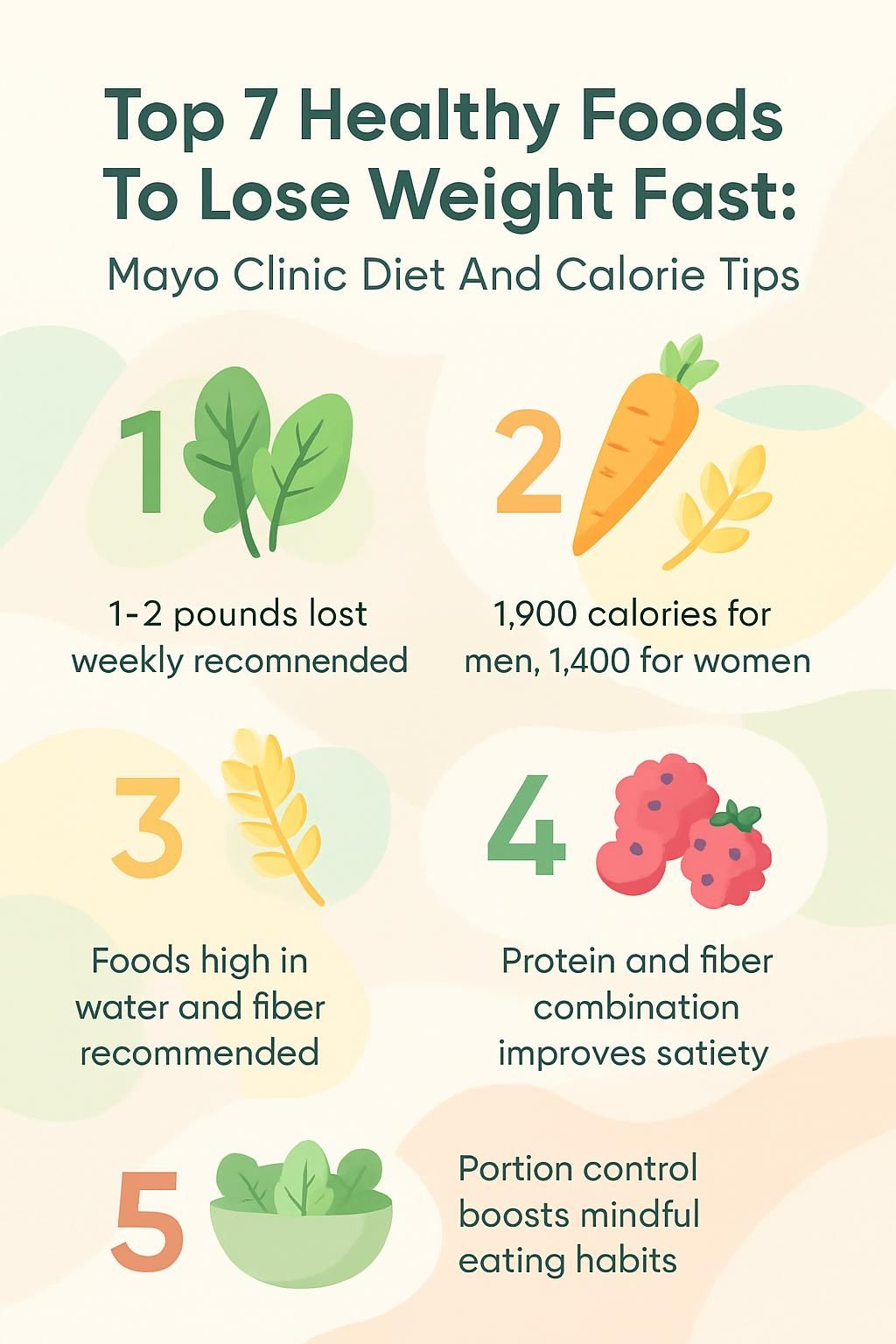
Understanding the Mayo Clinic Diet and Calorie Control

The Mayo Clinic Diet teaches you habits that support steady weight loss. The plan highlights low energy-dense foods, which means fewer calories per bite.
What is the Mayo Clinic Diet?
This approach guides you to fill your plate with foods high in water and fiber, like fruits and vegetables. These foods are low in calories and help you feel full.
You also learn portion size, how to limit saturated fat, and how to build balanced meals. Mayo Clinic updates, shared on January 12, 2024, reinforce these principles.
Energy density means calories per serving. Lower numbers allow larger portions for the same calories. Health professionals from Mayo Clinic Diet Online emphasize choosing foods that deliver nutrients with fewer calories.
Most people see a steady loss of about 1 to 2 pounds each week when they combine this plan with regular physical activity.
How Does Calorie Management Aid Weight Loss?
Calorie management means eating fewer calories than your body burns. Your body taps stored fat for energy, which reduces body weight over time.
Reducing intake by about 600 calories per day often leads to steady progress. Many men do well around 1,900 calories daily and many women around 1,400, based on NHS guidance.
Low energy-dense foods make this easier. For about 250 calories, you could eat a small order of fries or a large plate of produce, such as ten cups of spinach, one and a half cups of strawberries, and one small apple. The second option fills your stomach for the same calories.
Fruits and vegetables that are high in dietary fiber help control hunger. This supports a plan you can keep, week after week.
Health note: This article is educational. If you have a medical condition, diabetes, or take medications, talk with a licensed clinician or a registered dietitian before making big changes.
What Are Key Calorie Tips for Losing Weight Effectively?
Calorie control is a core part of every healthy diet. A few simple moves can lower your daily calories without constant hunger.
How Can I Choose Low-Calorie, Nutrient-Dense Foods?
Vegetables such as tomatoes, salad greens, carrots, asparagus, broccoli, and zucchini are low in calories and high in nutrients. Whole fruits usually offer fewer calories than dried fruit.
- One cup of grapes is about 104 calories, while one cup of raisins is about 480.
- Choose whole grains like oatmeal, brown rice, and whole-wheat bread for extra fiber and protein.
- Pick broth or tomato-based soups instead of creamy soups to lower calories.
- Swap white pasta for whole-wheat pasta for more fiber and better fullness.
The Mayo Clinic Diet focuses on foods that may help you feel full longer without adding too many calories per day. This helps people living with obesity or type 2 diabetes build a healthier pattern.
Low-calorie foods packed with nutrients let you eat more volume while taking in fewer calories.
Why Is Portion Control Important for Weight Loss?
Smaller plates and bowls make portions look larger, which helps your brain register a full meal. People who measure oils, weigh ingredients, and serve mindfully tend to manage calories better.
Portion awareness helps with meals and snacks like nuts, yogurt, cheese, and eggs. For people with diabetes, portion control supports blood sugar management and body fat reduction.
Studies show that paying attention to portions improves calorie control without cutting out entire food groups.
How Do Water-Rich Foods Help Keep Me Hydrated?
Many fruits and vegetables contain a lot of water, which supports hydration as you eat. You can reach daily fluid goals with drinks and with foods like soup and produce.
Mayo Clinic Diet guidance suggests getting 6 to 8 cups of fluids daily. Foods rich in water also lower the energy density of meals, so you can eat more for the same calories.
Spinach, cucumbers, watermelon, and strawberries are low in calories and very hydrating. Starting lunch with a vegetable soup often keeps you satisfied longer than a dry snack.
Water-rich choices like berries and salads can also increase fiber and micronutrients while supporting hydration.
What Are the Top 7 Healthy Foods to Lose Weight Quickly?
Some foods make calorie control simpler because they deliver protein, fiber, or healthy fats that support fullness.
How Do Eggs Support Weight Loss?
Eggs are rich in protein and contain healthy fats. A protein-rich breakfast helps you feel full for hours.
In a 2020 study, participants who ate eggs with toast felt fuller for four hours compared with a cereal, milk, and orange juice breakfast. Another study showed egg protein with high-fiber foods satisfied appetite better than low-fiber cereal.
Swapping sugary cereal for boiled or scrambled eggs can reduce morning snacking. Eggs fit well in calorie-controlled plans like the Mayo Clinic Diet.
Why Are Leafy Greens Like Spinach, Kale, and Collard Greens Good for Weight Loss?
Leafy greens are low in calories and high in fiber. Fiber slows digestion and supports appetite control.
One cup of raw spinach has about 7 calories, plus calcium and vitamin K. The water and fiber in these vegetables add volume and help with hydration.
Leafy greens contain thylakoids, plant compounds that may reduce hunger signals. Early research suggests benefits from whole foods, though scientists continue to study this area.
Adding spinach to sandwiches or mixing sautéed kale into salads makes meals more filling without many extra calories.
Which Fish Varieties Are Best for Losing Weight?
Salmon, cod, tilapia, trout, haddock, sardines, and tuna provide high-quality protein that supports muscle and fullness. Salmon offers omega-3 fatty acids, which support heart health, as noted by the American Heart Association.
- Cod, about 70 calories per 3 ounces cooked, provides over 15 grams of protein.
- Tilapia, fewer than 120 calories per 4 ounces, is a budget-friendly lean choice.
- Tuna packed in water is low in fat and fast to prepare.
- Sardines supply healthy fats and iodine, which supports thyroid function.
Many people feel satisfied longer after a fish meal. Grilled salmon with herbs became a go-to dinner for me during a calorie-control phase. It tasted great and kept me from late-night snacking.
How Do Cruciferous Vegetables Like Broccoli, Cauliflower, and Cabbage Help?
Broccoli, cauliflower, and cabbage are rich in fiber and water, yet low in calories. One cup of raw broccoli has about 2.3 grams of fiber and only 31 calories, based on the Dietary Guidelines for Americans.
These vegetables have low energy density, so you can eat a generous portion for fewer calories. They also provide vitamin C and plant nutrients being studied for disease prevention.
Roasted cauliflower paired with lean chicken or beans can keep you satisfied for hours.
What Are the Benefits of Lean Proteins Like Chicken Breast and Meats?
Skinless chicken breast and lean cuts of red meat, like tenderloin or flank steak, supply protein for muscle and satiety. They also provide iron, which supports energy and healthy blood.
Choose low-fat cooking methods such as baking, roasting, grilling, or sautéing with minimal oil. Limit heavy smoke during cooking.
Red meat can be part of a healthy diet in moderate amounts. Many people find that adding grilled chicken breast helps them stay full during a very-low-calorie phase.
How Can Beans and Legumes Aid Weight Loss?
Lentils, black beans, and kidney beans deliver both protein and fiber. That combination supports long-lasting fullness and better appetite control.
A 2016 systematic review and meta-analysis linked legumes with reduced body weight even without other diet changes. One cup of cooked black beans has about 15 grams of protein and 15 grams of fiber for roughly 225 calories.
Add half a cup of lentils or chickpeas to salads and soups, or serve them over brown rice. Many people find they eat less when meals include beans because of the fiber and water they contain.
Are Cottage Cheese and Greek Yogurt Good for Weight Loss?
Low-fat cottage cheese offers protein and calcium that help you feel full. A half-cup has about 14 grams of protein and around 80 calories.
Greek yogurt adds more protein and probiotics, which support gut health. Swapping dessert for plain Greek yogurt with berries can satisfy a sweet craving with fewer calories.
Some studies suggest that mindful portions of full-fat Greek yogurt may relate to lower risks of obesity and type 2 diabetes. Top dairy with chia seeds or almonds for extra fiber and crunch while keeping portions measured.
How Can Healthy Fats Support Weight Loss?
Healthy fats add flavor and satisfaction, which can reduce snacking. The key is choosing the right type and keeping portions controlled.
What Are the Benefits of Avocados for Weight Loss?
Avocados provide monounsaturated fat, a heart-friendly fat that supports fullness. They also contain water and fiber, two factors that lower the energy density of meals.
Avocados supply potassium, which supports blood pressure. They also help your body absorb fat-soluble vitamins A, D, E, and K from other foods.
One medium avocado has about 240 calories, so portion size matters. Add a few slices to a salad or a grain bowl to raise satisfaction without relying on heavy dressings.
How Do Nuts and Seeds Like Almonds, Chia Seeds, and Flaxseeds Help?
Nuts and seeds combine fiber, protein, and healthy fats. A one-ounce serving of nuts supports fullness and better metabolic health in many studies.
Chia seeds are rich in omega-3 fatty acids. In a 2017 trial, adding chia to yogurt increased fullness and reduced intake at the next meal. Flaxseeds add fiber that supports digestion and reduces snack cravings.
Keep servings measured. Their natural oils raise calories quickly, even though they offer solid nutrition.
Why Choose Olive Oil and Other Unsaturated Fats?
Oils like olive, flaxseed, and safflower contain unsaturated fats that are a better pick than saturated or trans fat found in many processed foods. Mayo Clinic experts advise swapping these in for butter or shortening when possible.
Olive oil is rich in monounsaturated fats that help lower LDL, the undesirable cholesterol, when used in place of solid fats. Diets that feature unsaturated fats support healthy metabolism for both children and adults.
Measure oil because it is calorie dense. Even small changes, like using a teaspoon less at the pan, can add up over the week.
What Role Do Whole Grains Play in Weight Loss?
Whole grains contain the bran and germ, which provide fiber and nutrients. Fiber increases fullness and steadies energy, which helps with calorie control.
How Does Brown Rice Aid Weight Loss?
Brown rice is a whole grain with fiber and protein. One cup cooked has about 3.5 grams of fiber and 5 grams of protein, which supports fullness after a meal.
It digests more slowly than refined grains, which helps prevent blood sugar spikes that drive hunger. People who eat whole grains, like brown rice, often have better outcomes associated with weight than those who prefer refined grains^1.
Combine brown rice with lean proteins such as chicken or with beans to build balanced, satisfying meals.
^1: Smith et al., Journal of Nutrition & Dietetics (2020).
Why Is Quinoa a Good Choice for Weight Loss?
Quinoa is rich in both protein and fiber. One cup cooked provides about 8 grams of protein and 5 grams of fiber for roughly 220 calories.
It contains essential amino acids, iron, magnesium, and B vitamins. Using quinoa as a base for bowls or salads can keep your energy steady and hunger in check.
Mayo Clinic experts encourage a variety of whole grains, including quinoa, to keep meals nutrient dense while managing calories.
How Does Oatmeal Support Weight Loss?
Oatmeal is a classic whole grain that supports fullness. One cup cooked has about 4 grams of fiber.
Its complex carbohydrates digest slowly, which helps prevent spikes in blood sugar. People who choose whole-grain carbs, such as oatmeal, often weigh less than those who choose refined grains, based on recent research.
Top oatmeal with blueberries or orange slices for a high-fiber breakfast that stays within your calorie budget.
Which Fruits Support Healthy Weight Loss?
Fruits bring fiber, water, and key vitamins. They are sweet, hydrating, and naturally low in calories.
How Do Berries Like Blueberries, Strawberries, and Raspberries Help?
Berries are low in calories and high in fiber. One cup of blueberries has about 80 calories and 4 grams of fiber. A cup of strawberries has about 49 calories and around 3 grams of fiber.
They provide vitamin C and anthocyanins, antioxidants that help protect cells. Mayo Clinic experts suggest mixing fruit choices to raise nutrient variety without many extra calories.
Frozen blueberries stirred into oatmeal or fresh strawberries on Greek yogurt make a filling snack or breakfast.
What Are the Benefits of Citrus Fruits Like Oranges, Grapefruits, and Lemons?
Citrus fruits help meet vitamin C needs and add hydration. One medium orange has about 62 calories and supplies over 90 percent of daily vitamin C.
Eating grapefruit before meals may help some people reduce calorie intake^1. Citrus offers a sweet taste with fiber, which helps control hunger between meals.
These fruits fit well in weight management plans, with or without a history of bariatric surgery.
1: Studies referenced in Mayo Clinic nutritional guidelines (2024).
What Other Foods Are Beneficial for Weight Loss?
A few more options can raise fullness and keep calories in check.
How Can Root Vegetables Like Potatoes Support Weight Loss?
Boiled white potatoes rank high on the Satiety Index, which measures how filling foods are. Many people feel satisfied for hours after a serving.
Cooling boiled potatoes forms resistant starch, a type of carbohydrate that digests slowly. Early animal research links it with improved weight control.
Bake or roast potatoes instead of frying. Potatoes also supply fiber, vitamin C, vitamin B6, and potassium when prepared with minimal added fat.
Why Are Soups a Good Low-Calorie Meal Option?
Vegetable-based clear soups are filling and light. A 2007 study found that starting a meal with soup increased fullness and led to lower calorie intake.
Soup also slows the pace of eating, which gives fullness signals time to catch up. Choose broth or tomato-based soups instead of creamy styles to keep calories down.
Starting lunch with a bowl of vegetable soup helped me stay satisfied through the afternoon with fewer snacks.
Can Chili Peppers Boost Metabolism and Aid Weight Loss?
Chili peppers contain capsaicin, a compound that can slightly increase calorie burning and reduce appetite for some people. Some studies show a small rise in calories burned after spicy meals, about 10 calories per meal.
Evidence for long-term weight loss is limited, so think of capsaicin as a flavor enhancer, not a main strategy. Adding small amounts to meals may support a healthy eating pattern like the Mayo Clinic Diet.
What Are Mayo Clinic’s Calorie Tips for Weight Loss?
Smart calorie moves help you manage daily intake while staying satisfied.
How Can Managing Meal Energy Density Help?
Low energy-dense foods allow bigger portions for fewer calories. For example, one pat of butter has a similar calorie count to two cups of raw broccoli.
Fill half your plate with water-rich vegetables, then add lean protein and a whole grain. Mixing chopped spinach or tomatoes into pasta lowers calories while keeping volume high.
These strategies support hunger control and help you stay within your calorie target.
Why Should I Avoid Processed and High-Sugar Foods?
Processed snacks and sugary drinks pack many calories into small portions. They often cause blood sugar to spike and drop, which can trigger hunger.
People who limit ultra-processed foods tend to lose weight faster and maintain it longer. Swap soda for water or unsweetened tea, and choose fruit or yogurt for a sweet bite.
I replaced soda with water for two weeks and noticed fewer cravings and more stable energy.
How Does Combining High-Protein with High-Fiber Foods Benefit Weight Loss?
Pairing protein with fiber increases fullness and slows digestion. That helps you eat fewer calories without feeling deprived.
In a 2022 study of 460 adults with type 2 diabetes, chia seeds, whole grains, cruciferous vegetables, and legumes helped reduce belly fat as part of a calorie-controlled plan.
Build meals with Greek yogurt or chicken breast plus fiber-rich sides like broccoli or beans. The Mayo Clinic Diet suggests filling at least half the plate with vegetables and lean protein.
How Can I Develop Sustainable Eating Habits?
Habits make results stick. Practical skills help you stay on track during busy weeks and stressful days.
What Is Mindful Eating and How Does It Help?
Mindful eating means slowing down, noticing flavors and textures, and checking your hunger cues. Choosing foods that take longer to eat, like whole fruits or soup, can boost satisfaction.
People who slow their pace often eat fewer calories at meals. Swapping a sandwich for a bowl of vegetable soup at lunch helped me feel full sooner and snack less in the afternoon.
Mindful habits support portion control and help you make choices that fit your goals.
How Do Meal Planning and Tracking Improve Weight Loss Success?
Planning and tracking make calorie control more consistent. They also reduce last-minute decisions that can derail progress.
- Use a meal planning app, such as the NHS Weight Loss Plan, to set weekly goals and log meals for up to 12 weeks.
- Prep meals in advance. Weigh key ingredients or use smaller plates to keep portions in line.
- Track calories and nutrients. People who log intake often lose more weight than those who do not.
- Pick recipes with low-calorie, nutrient-dense foods from trusted lists like the Mayo Clinic healthy foods list.
- Review progress weekly with a digital tool or a paper journal. Spot trends early and adjust.
These skills reinforce mindful eating and keep your plan realistic for daily life.
Conclusion
Nutrient-dense foods help you reach a healthy weight without constant hunger. Eggs, leafy greens, fish, lean meats, beans, and Greek yogurt offer protein and key nutrients that support fullness.
Potatoes, soups, berries, and whole grains add fiber or water, so you eat fewer calories and still feel satisfied. Portion control and simple tracking strengthen results on the Mayo Clinic Diet.
This information is for education. If you have medical concerns or take prescription medicines, talk with your healthcare professional before changing your diet or physical activity plan.
FAQs
1. What are the top seven nutritious foods for rapid weight loss according to the Mayo Clinic Diet and calorie guidelines?
The most effective foods include leafy greens, whole grains, lean poultry, legumes, low-fat dairy products, berries, and cruciferous vegetables. These choices offer high fiber or protein content with fewer calories per serving. Research from the Mayo Clinic supports their role in promoting satiety and supporting healthy metabolism.
2. How do these recommended foods help reduce calorie intake while maintaining nutrition?
Leafy greens such as spinach provide essential vitamins with minimal calories. Whole grains like brown rice deliver sustained energy due to complex carbohydrates and fiber content. Lean poultry offers protein that helps preserve muscle during weight loss efforts; this is supported by clinical studies on dietary patterns.
3. Can you share a personal experience using these foods within a structured diet plan?
After incorporating more legumes and cruciferous vegetables into my meals alongside regular exercise, I noticed improved fullness after eating smaller portions. Tracking daily intake using a food diary helped me stay consistent with calorie goals outlined by the Mayo Clinic Diet.
4. Are there specific tips for integrating these foods into everyday meals based on evidence-based strategies?
Prepare salads featuring leafy greens at lunch or dinner; swap refined grains for whole grain options in recipes; use lean poultry instead of processed meats; add beans to soups or stews; choose low-fat yogurt over full-fat alternatives; snack on fresh berries rather than sweets; steam broccoli or cauliflower as side dishes. Studies indicate that gradual changes increase adherence to healthy eating habits.
Summary: The Mayo Clinic Diet highlights nutrient-dense options like leafy greens and whole grains for effective weight management through reduced caloric density without sacrificing essential nutrients or satisfaction at meals.

